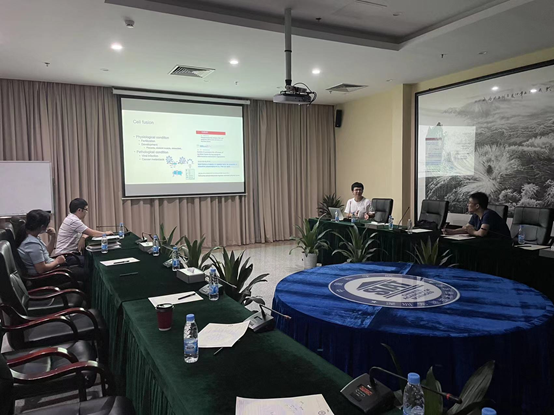On August 4, 2022, Researcher Zhang Yang from Shenzhen Bay Laboratory was invited to Shenzhen Institutes of Advanced Technology for academic exchanges and delivered an academic report titled "TMEM16F phospholipid scramblase mediates cell-cell fusion". Cell fusion is fundamental to the reproduction, development, and homeostasis of multicellular organisms. In addition to various cell type-specific fusogenic proteins, cell surface externalization of phosphatidylserine (PS), a universal eat-me signal in apoptotic cells, has been observed in different cell fusion events. Nevertheless, the molecular underpinnings of PS externalization and cellular mechanisms of PS-facilitated cell-cell fusion are unclear. Our lab report that TMEM16F, a Ca2+-activated phospholipid scramblase (CaPLSase), plays an essential role in placental trophoblast fusion by translocating PS to cell surface independent of apoptosis. We also identify one of the physiological activation mechanisms of TMEM16F in human trophoblast fusion. Our findings provide insight into understanding cell fusion mechanism of other cell types and demonstrate one approach to understand TMEM16F’s biological functions in wide-ranging physiological and pathological processes, including blood coagulation, bone mineralization, HIV infection, trophoblast fusion, and SARS-CoV2-mediated syncytialization.

Researcher Zhang Yang communicated with the teachers and students of Shenzhen Institutes of Advanced Technology
Personal Profiles:
Zhang Yang is a Distinguished Researcher at Shenzhen Bay Laboratory. He obtained his Ph.D. degree from Huazhong University of Science and Technology in 2014. From 2014 to 2015, he served as an Assistant Researcher at Shenzhen Institutes of Advanced Technology, Chinese Academy of Sciences. From 2015 to 2022, he was employed at the School of Medicine, Duke University. In 2022, he joined Shenzhen Bay Laboratory. He mainly engages in the research on the transmembrane transport of ions and phospholipids. By using a variety of molecular methods and combining techniques such as electrophysiology and optical imaging, his research group studies the functions of ion channels and phospholipid scramblases in physiological and pathological conditions, providing treatment strategies for diseases related to abnormal neural development, coagulation disorders, viral infections, etc. He has successively published 17 papers in journals such as Neuron, Science Advances, eLife, IEEE Transactions on Medical Imaging, PNAS, and Cancer Discovery. He has successively won the Joy Cappel Young Scientist Award, the Burroughs Wellcome Fund Collaborative Research Award, the Layton Holladay Memorial Fund Award, the Gordon Research Conference Best Poster Presentation Award, and other honors.